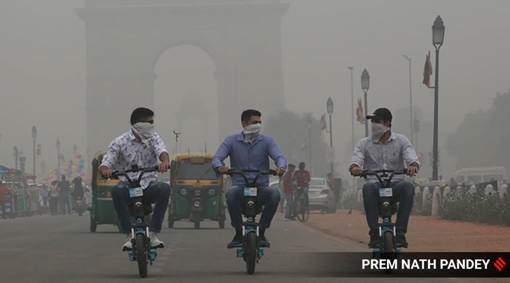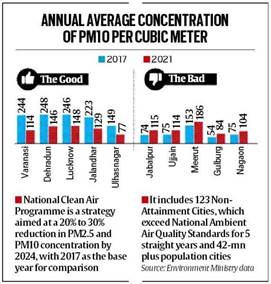Description

Copyright infringement not intended
Context:
Twenty cities out of 131 selected by the Union Environment Ministry for its National Clean Air Programme (NCAP) have attained the National Ambient Air Quality Standards (60 microgram per cubic meter) in 2021-22, compared to their 2017 levels, the ministry disclosed.

Details:
- Ninety-five of these 131 cities have shown air quality improvement, with Varanasi recording the most marked improvement — of 53% — in air quality levels, the ministry stated. Varanasi had an annual average concentration of PM10 of 244 in 2017, which dropped to 144 in 2021.
- Marking the UN International Day of Clean Air for Blue Skies on 7th September, Union Environment Minister said, “When we commenced the Clean Air Mission programme last year, it was our endeavour to work on it from the grassroots level, as the topic of clean air is a matter of priority for the government. Our aim is for NCAP to address the problems of air pollution at regional level, as circumstances and reasons for it are different in different regions.”
- Stating that one of the challenges the government has faced in implementing NCAP has been lack of adequate data, Yadav said this issue is “being addressed”. From now, he said, urban centres “must take into account mitigation of air pollution during planning stages”.
- PM10 data disclosed by the ministry shows that all metropolitan cities — Delhi, Bengaluru, Mumbai, Chennai, Kolkataand Hyderabad — have shown significant improvement in air quality in 2021-22 compared to 2017.

- But, the data shows, 27 cities have shown a deterioration in air quality over the same period.
- Among them is Korba — the district in Chhattisgarh houses 10 thermal coal power plants — for which the state human rights commission had sought a report on the district’s poor air quality from the state government several years ago.
- Among states, Madhya Pradesh has been the poorest performer, as six of seven cities from the state selected by the Centre for NCAP have shown a deterioration in air quality.
- Howrah and Durgapur in West Bengal, Aurangabad and Thane in Maharashtra, Gaya in Bihar, Rajkot and Vadodara in Gujarat, Bhubaneswar (Odisha), Patiala (Punjab) and Jammu, among others, have also shown a worsening of air quality.
- All 131 cities have developed City Action Plans and Micro Action Plans to address various sources contributing to poor air quality, such as an increasing number of vehicles, road dust, pollutants from construction, industries, thermal power plants, burning of waste, construction and demolition waste, among others.
https://indianexpress.com/article/india/air-clears-to-show-the-good-and-the-bad-95-of-131-cities-improve-27-worsen-8137641/










